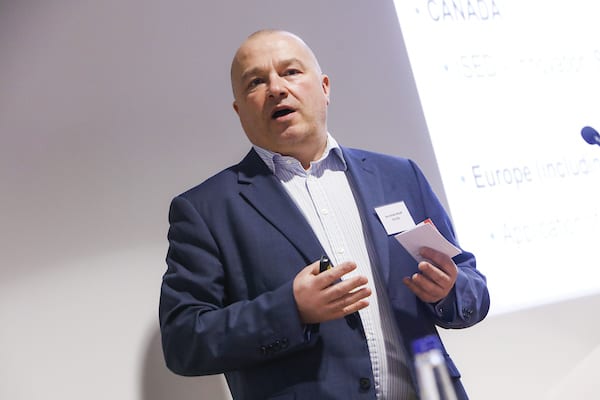
International product certification regulations are really boring, right up to the point where they become extremely interesting – and if you’re an industry physicist trying to sell your whizzy new device in other countries, you really, really don’t want them to become interesting.
That, at least, was the message I took from a talk by Joe Lomako and Rob Campling, who spoke about “Global Market Access” at the Institute of Physics’ inaugural Business Innovation and Growth Conference on 26 February. Lomako and Campling work for the testing and certification firm TÜV SÜD, and during their talk they explained the principles of product certification, the different approaches taken in various parts of the globe, and the consequences of getting it wrong. In some countries, those consequences may include unlimited fines for the company responsible and prison time for people involved in mis-selling goods.
Like I said: regulations are boring, until they bankrupt your company or send you to jail.
At the beginning of the workshop, Lomako asked the audience of industry physicists at what stage they thought they should start taking regulatory compliance into account. “Maybe when you’re looking to sell into a new market?” suggested one participant. “At the design stage,” offered another. Lomako, however, argued that it should be even earlier, when the product is still just a concept, because some apparently similar technologies fall under very different regulations.
For example, suppose you have an idea for a medical sensor. Naturally, you want your sensor to transmit its data to another machine. If you do this via a Bluetooth connection, the process of getting it certified under, say, the European Union’s CE-marking scheme will cost on the order of £15 000. However, if you build that same sensor with a mobile phone connection instead, Campling estimates that certification costs will run into six figures.
Considerations like these are becoming more important now that so many connective devices are entering the market, as part of the so-called Internet of Things. “A product has to have Bluetooth because it’s the sexy buzzword,” Campling observed. “Even if it’s not needed, like for a vacuum cleaner, it has to have wireless in it.” As a result, products like the aforementioned medical sensor may need to comply with directives about radio equipment and electromagnetic compatibility, as well as those specifically aimed at medical devices and procedures.
Ensuring that a product is safe, and that it won’t interfere with other devices, are two of the main drivers behind these regulations. But other motivations may be in play as well, and Campling urged industry scientists to take them into account when considering where their target markets should be. For example, some governments deliberately make certification difficult, to protect local industries. Others make money from selling certification, especially for devices that use the radio spectrum.

The burden of complying with all these regulations can be high, but Campling stressed that the alternative isn’t worth it. Even without fines or criminal penalties, a containerload of non-compliant goods could get tied up in customs for weeks while the requisite paperwork is completed, racking up storage costs of up to hundreds of dollars per product per day. “Some people don’t even know that regulations apply to them until they get stopped at customs,” Lomako observed, adding that even big companies sometimes get caught out – for example, by learning that a particular technology is no longer allowed in a target market after they’ve spent £0.5m designing it.
With all this talk about international trade and regulations, it was inevitable that the B-word – Brexit – would come up at some point. Unfortunately, in this case, the presenters had no answers. Although a new UK-specific certification system is being developed to replace the CE mark in the event of a no-deal Brexit, Lomako observed that “nobody really knows at this stage” what will happen after the UK’s scheduled departure from the EU on 29 March. “The next few weeks will tell,” he concluded.



